Biostatistics for Public Health TM5516 Assignment 1 Solutions Analysis
VerifiedAdded on 2023/03/17
|17
|2768
|86
Homework Assignment
AI Summary
This document provides a detailed solution for Biostatistics for Public Health (TM5516) Assignment 1. The assignment covers various statistical concepts including cumulative distribution, conditional probability, and normal distribution. It involves calculating probabilities related to aortic diameter expansion, Alzheimer's screening test sensitivity, and specificity. The solutions also include Poisson and binomial distributions to analyze patient appointments and CBA symptom development. Furthermore, the assignment addresses hypothesis testing, confidence intervals, and descriptive statistics (mean, standard deviation, median, quartiles, and interquartile range) for comparing sitting hours between males and females. The solutions provide step-by-step calculations, interpretations, and conclusions for each problem, offering a comprehensive guide for students studying biostatistics in a public health context.
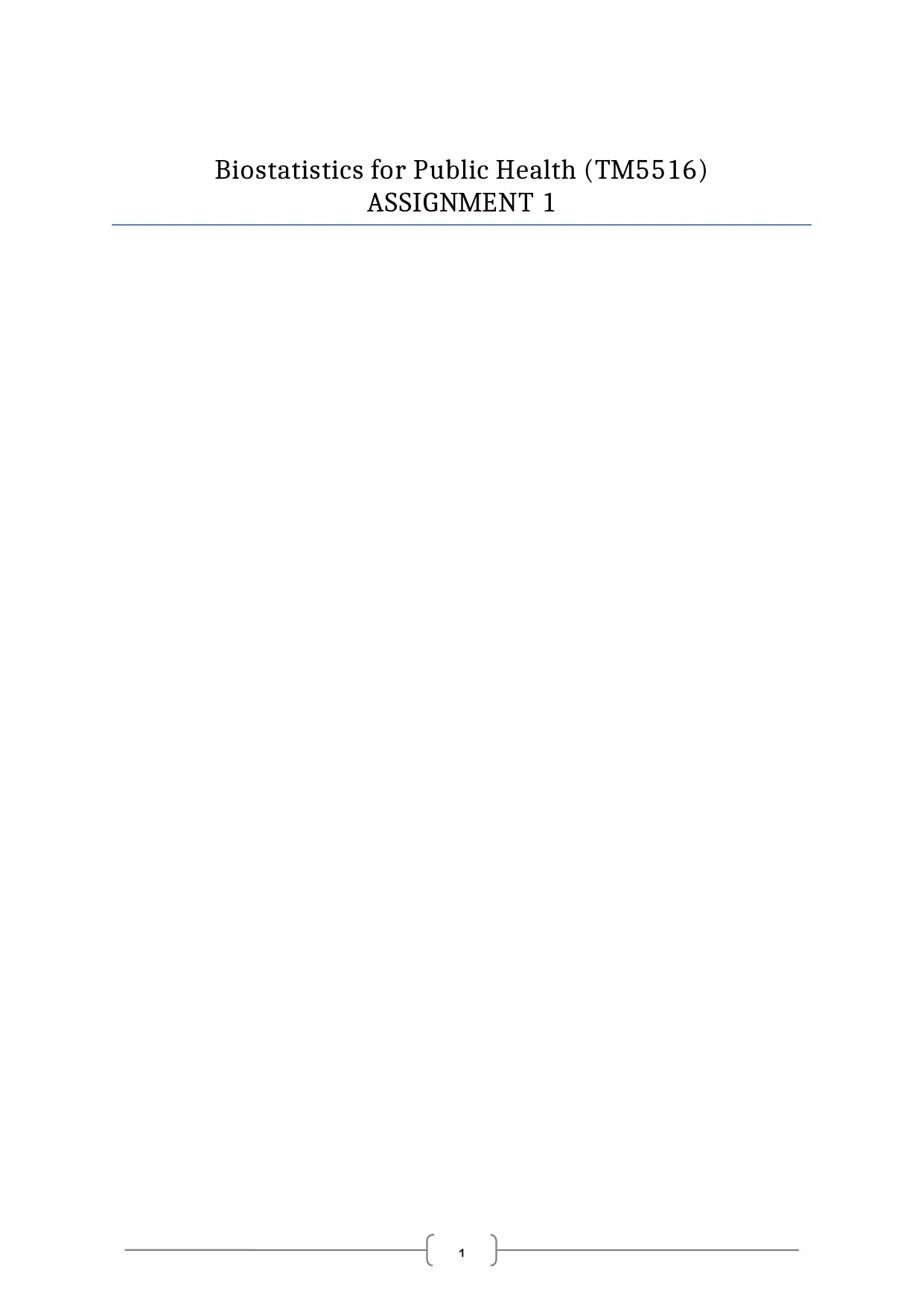
1
Biostatistics for Public Health (TM5516)
ASSIGNMENT 1
Biostatistics for Public Health (TM5516)
ASSIGNMENT 1
Paraphrase This Document
Need a fresh take? Get an instant paraphrase of this document with our AI Paraphraser
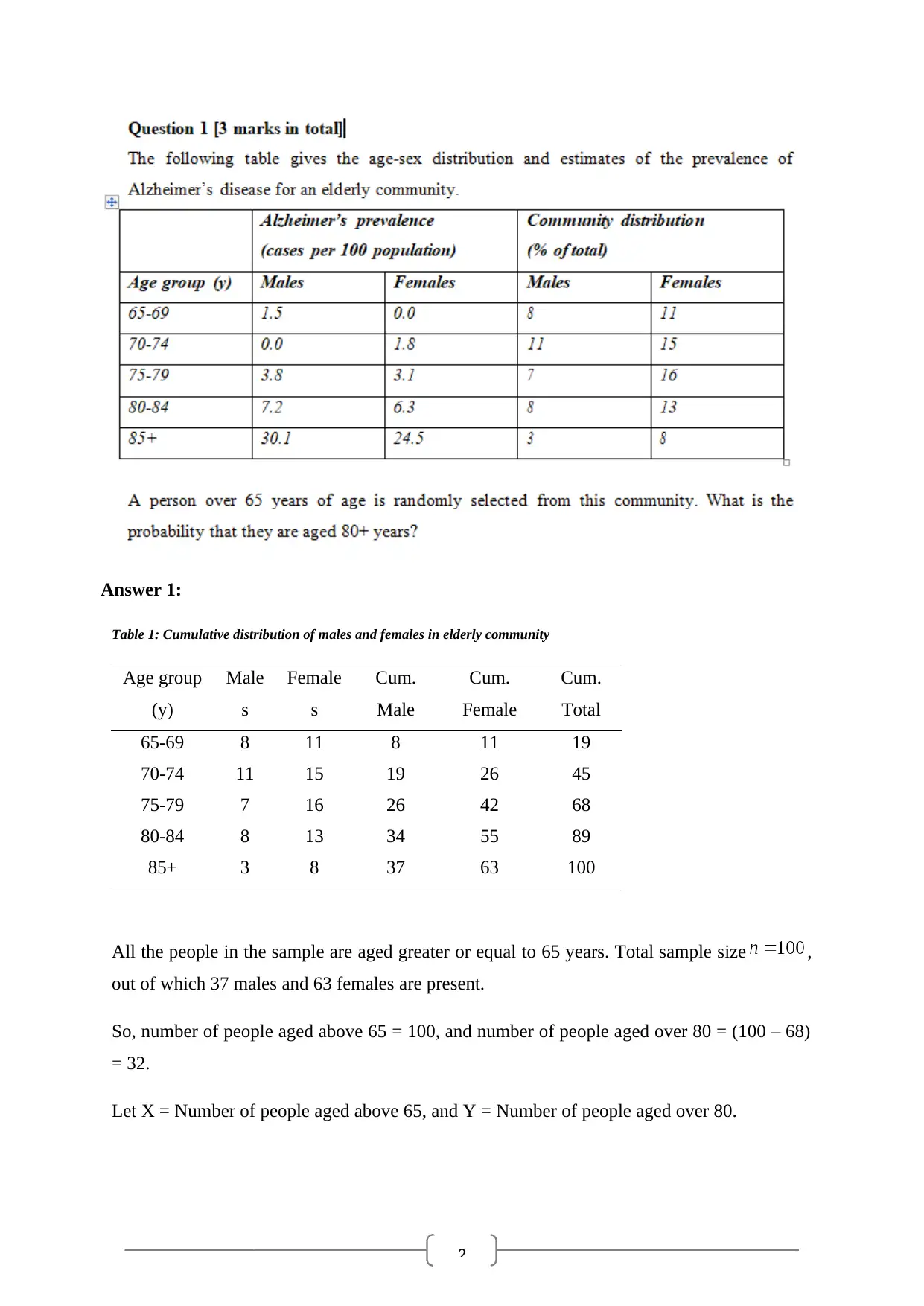
2
Answer 1:
Table 1: Cumulative distribution of males and females in elderly community
Age group
(y)
Male
s
Female
s
Cum.
Male
Cum.
Female
Cum.
Total
65-69 8 11 8 11 19
70-74 11 15 19 26 45
75-79 7 16 26 42 68
80-84 8 13 34 55 89
85+ 3 8 37 63 100
All the people in the sample are aged greater or equal to 65 years. Total sample size ,
out of which 37 males and 63 females are present.
So, number of people aged above 65 = 100, and number of people aged over 80 = (100 – 68)
= 32.
Let X = Number of people aged above 65, and Y = Number of people aged over 80.
Answer 1:
Table 1: Cumulative distribution of males and females in elderly community
Age group
(y)
Male
s
Female
s
Cum.
Male
Cum.
Female
Cum.
Total
65-69 8 11 8 11 19
70-74 11 15 19 26 45
75-79 7 16 26 42 68
80-84 8 13 34 55 89
85+ 3 8 37 63 100
All the people in the sample are aged greater or equal to 65 years. Total sample size ,
out of which 37 males and 63 females are present.
So, number of people aged above 65 = 100, and number of people aged over 80 = (100 – 68)
= 32.
Let X = Number of people aged above 65, and Y = Number of people aged over 80.
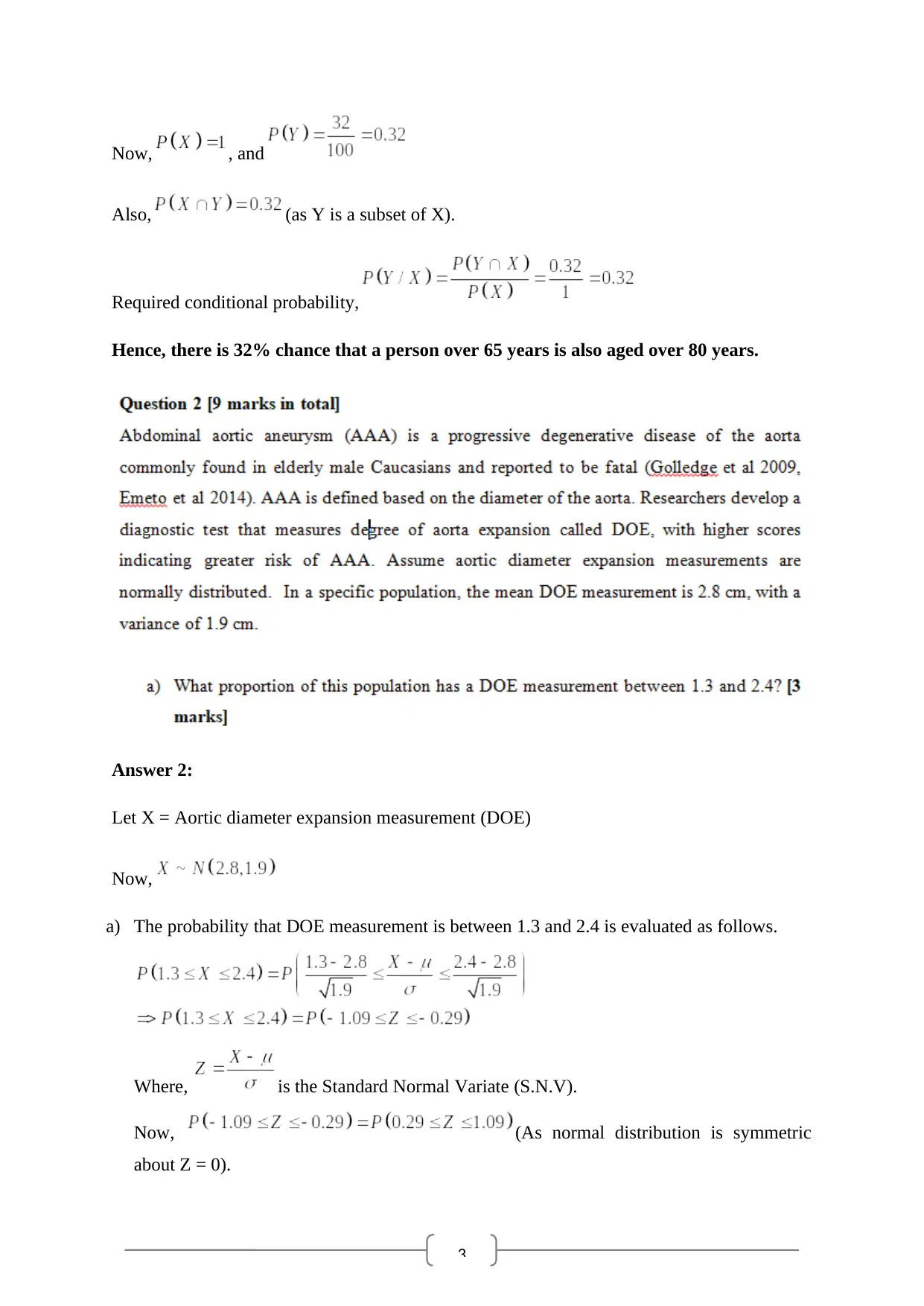
3
Now, , and
Also, (as Y is a subset of X).
Required conditional probability,
Hence, there is 32% chance that a person over 65 years is also aged over 80 years.
Answer 2:
Let X = Aortic diameter expansion measurement (DOE)
Now,
a) The probability that DOE measurement is between 1.3 and 2.4 is evaluated as follows.
Where, is the Standard Normal Variate (S.N.V).
Now, (As normal distribution is symmetric
about Z = 0).
Now, , and
Also, (as Y is a subset of X).
Required conditional probability,
Hence, there is 32% chance that a person over 65 years is also aged over 80 years.
Answer 2:
Let X = Aortic diameter expansion measurement (DOE)
Now,
a) The probability that DOE measurement is between 1.3 and 2.4 is evaluated as follows.
Where, is the Standard Normal Variate (S.N.V).
Now, (As normal distribution is symmetric
about Z = 0).
⊘ This is a preview!⊘
Do you want full access?
Subscribe today to unlock all pages.

Trusted by 1+ million students worldwide
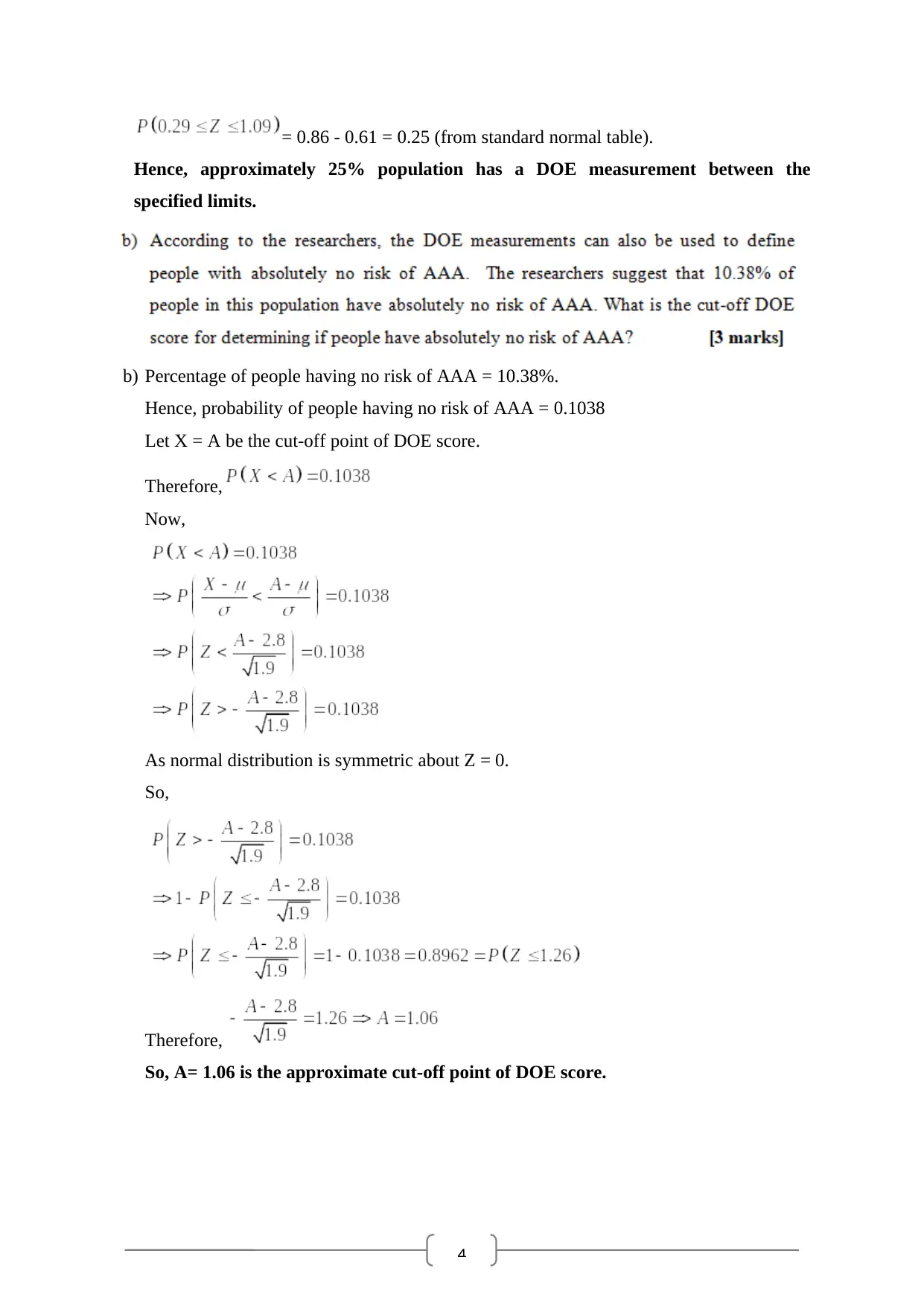
4
= 0.86 - 0.61 = 0.25 (from standard normal table).
Hence, approximately 25% population has a DOE measurement between the
specified limits.
b) Percentage of people having no risk of AAA = 10.38%.
Hence, probability of people having no risk of AAA = 0.1038
Let X = A be the cut-off point of DOE score.
Therefore,
Now,
As normal distribution is symmetric about Z = 0.
So,
Therefore,
So, A= 1.06 is the approximate cut-off point of DOE score.
= 0.86 - 0.61 = 0.25 (from standard normal table).
Hence, approximately 25% population has a DOE measurement between the
specified limits.
b) Percentage of people having no risk of AAA = 10.38%.
Hence, probability of people having no risk of AAA = 0.1038
Let X = A be the cut-off point of DOE score.
Therefore,
Now,
As normal distribution is symmetric about Z = 0.
So,
Therefore,
So, A= 1.06 is the approximate cut-off point of DOE score.
Paraphrase This Document
Need a fresh take? Get an instant paraphrase of this document with our AI Paraphraser
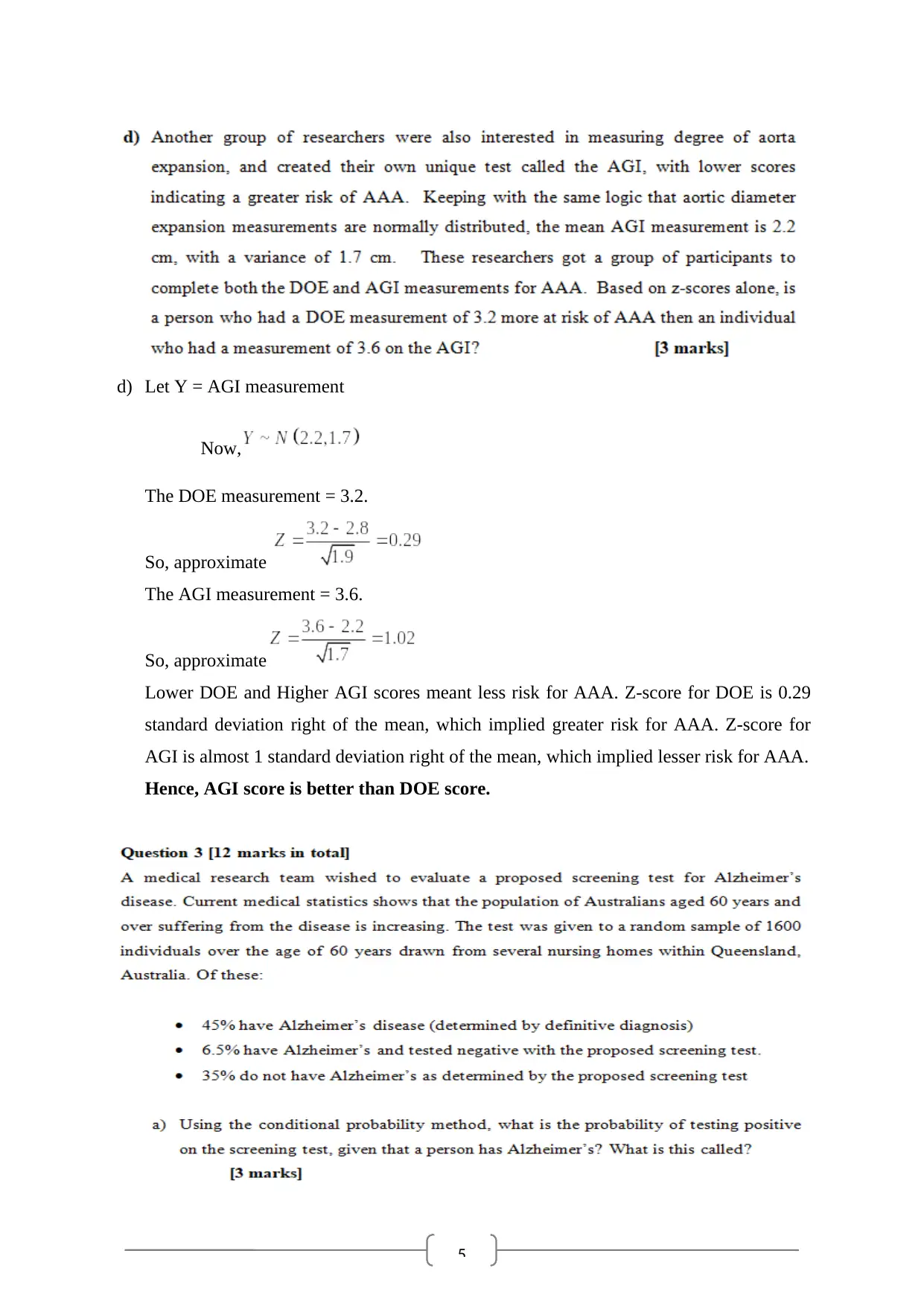
5
d) Let Y = AGI measurement
Now,
The DOE measurement = 3.2.
So, approximate
The AGI measurement = 3.6.
So, approximate
Lower DOE and Higher AGI scores meant less risk for AAA. Z-score for DOE is 0.29
standard deviation right of the mean, which implied greater risk for AAA. Z-score for
AGI is almost 1 standard deviation right of the mean, which implied lesser risk for AAA.
Hence, AGI score is better than DOE score.
d) Let Y = AGI measurement
Now,
The DOE measurement = 3.2.
So, approximate
The AGI measurement = 3.6.
So, approximate
Lower DOE and Higher AGI scores meant less risk for AAA. Z-score for DOE is 0.29
standard deviation right of the mean, which implied greater risk for AAA. Z-score for
AGI is almost 1 standard deviation right of the mean, which implied lesser risk for AAA.
Hence, AGI score is better than DOE score.
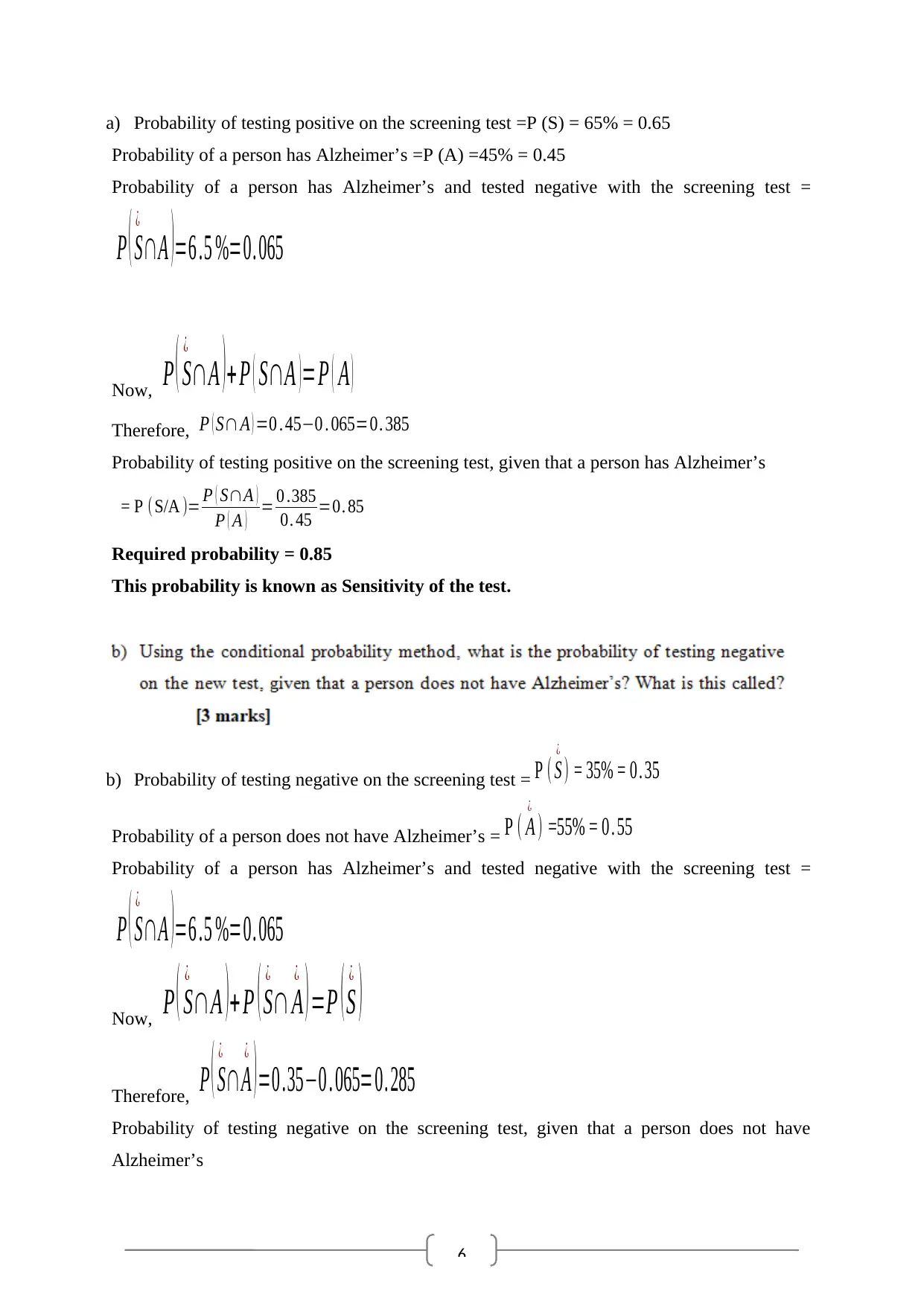
6
a) Probability of testing positive on the screening test =P (S) = 65% = 0.65
Probability of a person has Alzheimer’s =P (A) =45% = 0.45
Probability of a person has Alzheimer’s and tested negative with the screening test =
P ( S
¿
∩A ) =6 .5 %=0. 065
Now, P ( S
¿
∩A ) + P ( S∩A ) =P ( A )
Therefore, P ( S∩ A ) =0 . 45−0 . 065=0. 385
Probability of testing positive on the screening test, given that a person has Alzheimer’s
= P (S/A )= P ( S∩A )
P ( A ) = 0 .385
0. 45 =0. 85
Required probability = 0.85
This probability is known as Sensitivity of the test.
b) Probability of testing negative on the screening test = P ( S
¿
) = 35% = 0 . 35
Probability of a person does not have Alzheimer’s = P ( A
¿
) =55% = 0 . 55
Probability of a person has Alzheimer’s and tested negative with the screening test =
P ( S
¿
∩A ) =6 .5 %=0. 065
Now, P ( S
¿
∩A ) + P ( S
¿
∩ A
¿
) =P ( S
¿
)
Therefore, P ( S
¿
∩A
¿
) =0 .35−0 . 065=0. 285
Probability of testing negative on the screening test, given that a person does not have
Alzheimer’s
a) Probability of testing positive on the screening test =P (S) = 65% = 0.65
Probability of a person has Alzheimer’s =P (A) =45% = 0.45
Probability of a person has Alzheimer’s and tested negative with the screening test =
P ( S
¿
∩A ) =6 .5 %=0. 065
Now, P ( S
¿
∩A ) + P ( S∩A ) =P ( A )
Therefore, P ( S∩ A ) =0 . 45−0 . 065=0. 385
Probability of testing positive on the screening test, given that a person has Alzheimer’s
= P (S/A )= P ( S∩A )
P ( A ) = 0 .385
0. 45 =0. 85
Required probability = 0.85
This probability is known as Sensitivity of the test.
b) Probability of testing negative on the screening test = P ( S
¿
) = 35% = 0 . 35
Probability of a person does not have Alzheimer’s = P ( A
¿
) =55% = 0 . 55
Probability of a person has Alzheimer’s and tested negative with the screening test =
P ( S
¿
∩A ) =6 .5 %=0. 065
Now, P ( S
¿
∩A ) + P ( S
¿
∩ A
¿
) =P ( S
¿
)
Therefore, P ( S
¿
∩A
¿
) =0 .35−0 . 065=0. 285
Probability of testing negative on the screening test, given that a person does not have
Alzheimer’s
⊘ This is a preview!⊘
Do you want full access?
Subscribe today to unlock all pages.

Trusted by 1+ million students worldwide
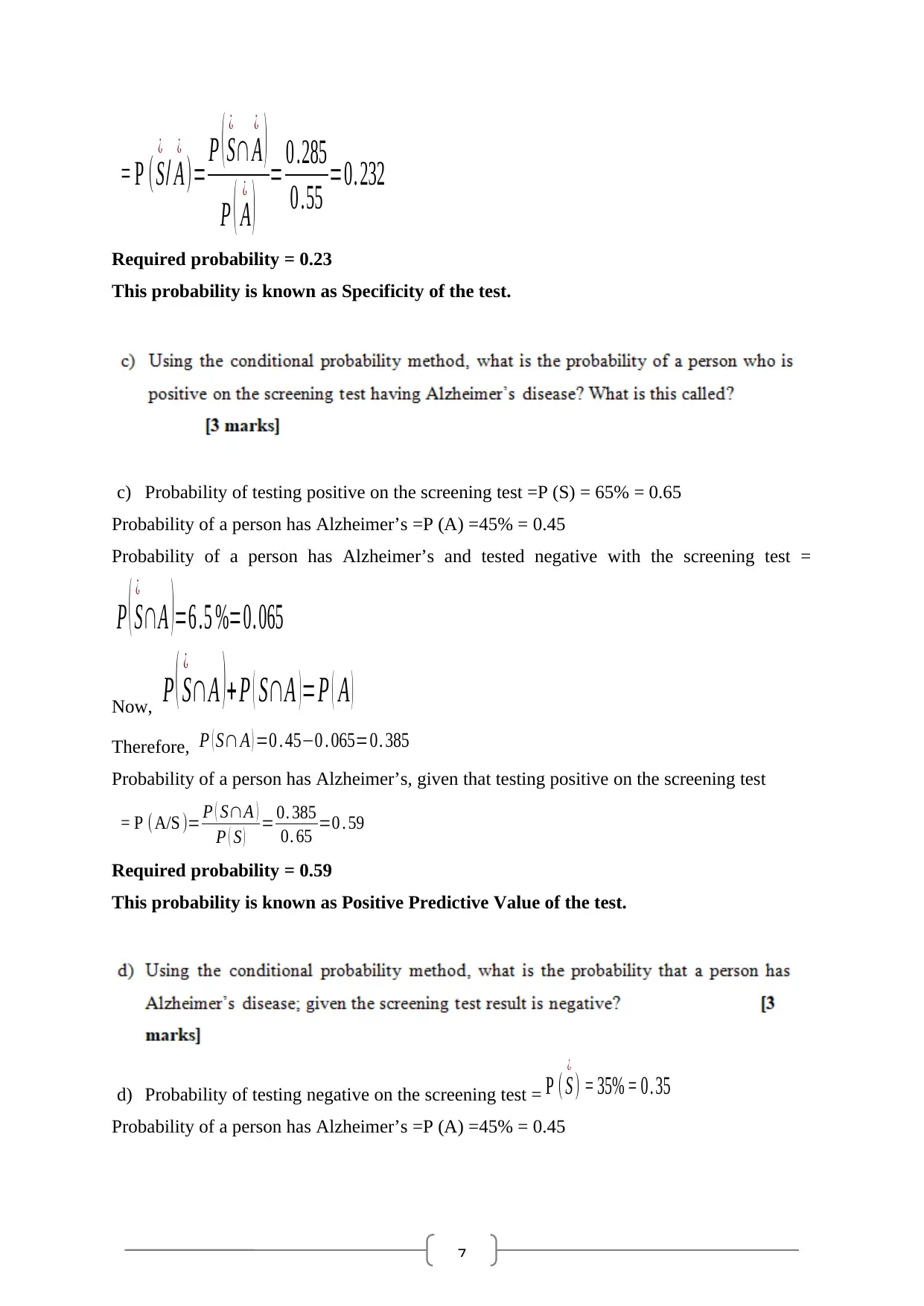
7
= P ( S
¿
/ A
¿
)= P ( S
¿
∩ A
¿
)
P ( A
¿
) = 0 .285
0 .55 =0. 232
Required probability = 0.23
This probability is known as Specificity of the test.
c) Probability of testing positive on the screening test =P (S) = 65% = 0.65
Probability of a person has Alzheimer’s =P (A) =45% = 0.45
Probability of a person has Alzheimer’s and tested negative with the screening test =
P ( S
¿
∩A ) =6 .5 %=0. 065
Now, P ( S
¿
∩A ) + P ( S∩A ) =P ( A )
Therefore, P ( S∩ A ) =0 . 45−0 . 065=0. 385
Probability of a person has Alzheimer’s, given that testing positive on the screening test
= P (A/S )= P ( S∩A )
P ( S ) = 0. 385
0. 65 =0 . 59
Required probability = 0.59
This probability is known as Positive Predictive Value of the test.
d) Probability of testing negative on the screening test = P ( S
¿
) = 35% = 0 . 35
Probability of a person has Alzheimer’s =P (A) =45% = 0.45
= P ( S
¿
/ A
¿
)= P ( S
¿
∩ A
¿
)
P ( A
¿
) = 0 .285
0 .55 =0. 232
Required probability = 0.23
This probability is known as Specificity of the test.
c) Probability of testing positive on the screening test =P (S) = 65% = 0.65
Probability of a person has Alzheimer’s =P (A) =45% = 0.45
Probability of a person has Alzheimer’s and tested negative with the screening test =
P ( S
¿
∩A ) =6 .5 %=0. 065
Now, P ( S
¿
∩A ) + P ( S∩A ) =P ( A )
Therefore, P ( S∩ A ) =0 . 45−0 . 065=0. 385
Probability of a person has Alzheimer’s, given that testing positive on the screening test
= P (A/S )= P ( S∩A )
P ( S ) = 0. 385
0. 65 =0 . 59
Required probability = 0.59
This probability is known as Positive Predictive Value of the test.
d) Probability of testing negative on the screening test = P ( S
¿
) = 35% = 0 . 35
Probability of a person has Alzheimer’s =P (A) =45% = 0.45
Paraphrase This Document
Need a fresh take? Get an instant paraphrase of this document with our AI Paraphraser
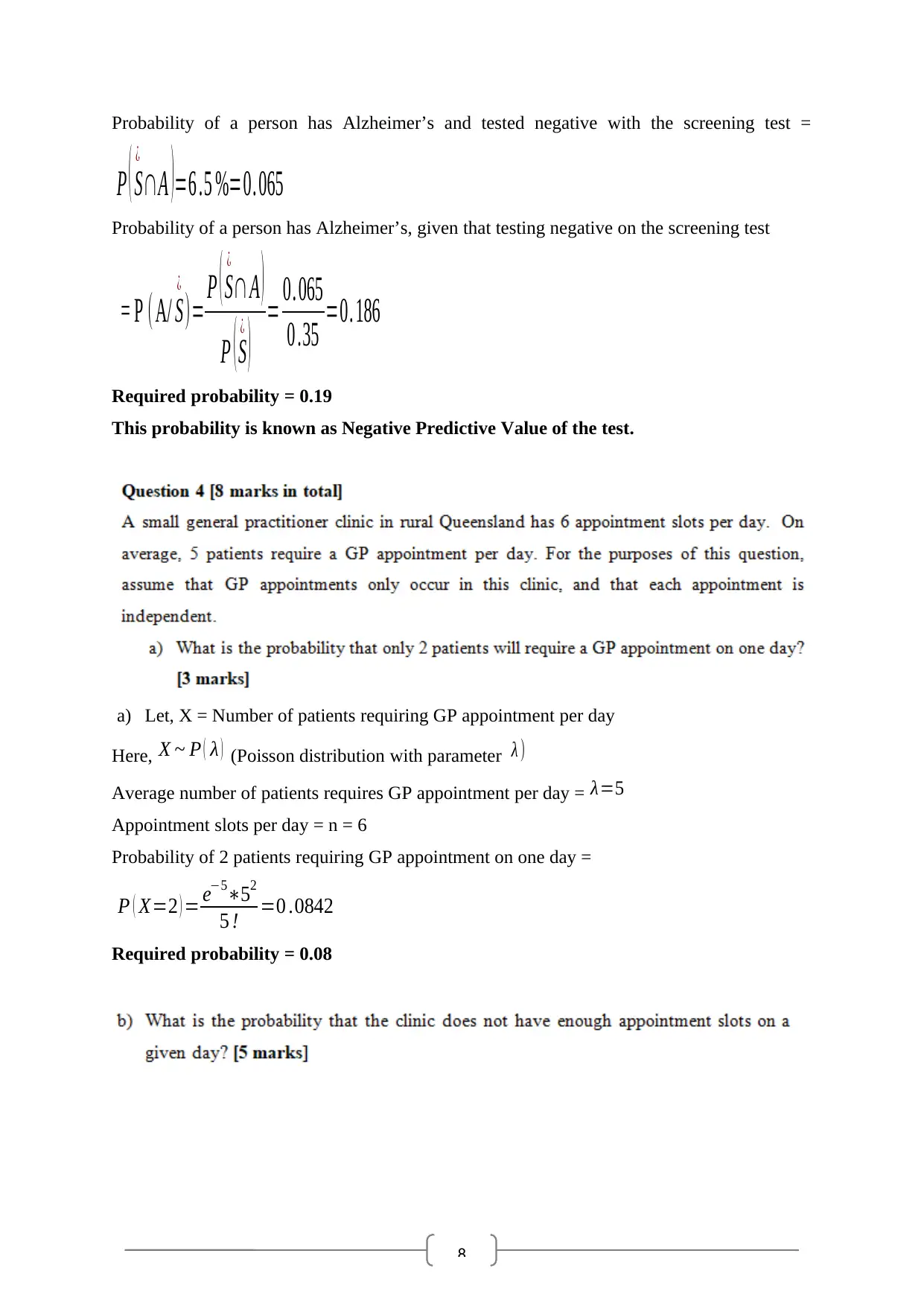
8
Probability of a person has Alzheimer’s and tested negative with the screening test =
P ( S
¿
∩A ) =6 .5 %=0. 065
Probability of a person has Alzheimer’s, given that testing negative on the screening test
= P (A/ S
¿
)= P ( S
¿
∩ A )
P ( S
¿
) = 0. 065
0 .35 =0. 186
Required probability = 0.19
This probability is known as Negative Predictive Value of the test.
a) Let, X = Number of patients requiring GP appointment per day
Here, X ~ P ( λ ) (Poisson distribution with parameter λ )
Average number of patients requires GP appointment per day = λ=5
Appointment slots per day = n = 6
Probability of 2 patients requiring GP appointment on one day =
P ( X=2 ) = e−5∗52
5 ! =0 .0842
Required probability = 0.08
Probability of a person has Alzheimer’s and tested negative with the screening test =
P ( S
¿
∩A ) =6 .5 %=0. 065
Probability of a person has Alzheimer’s, given that testing negative on the screening test
= P (A/ S
¿
)= P ( S
¿
∩ A )
P ( S
¿
) = 0. 065
0 .35 =0. 186
Required probability = 0.19
This probability is known as Negative Predictive Value of the test.
a) Let, X = Number of patients requiring GP appointment per day
Here, X ~ P ( λ ) (Poisson distribution with parameter λ )
Average number of patients requires GP appointment per day = λ=5
Appointment slots per day = n = 6
Probability of 2 patients requiring GP appointment on one day =
P ( X=2 ) = e−5∗52
5 ! =0 .0842
Required probability = 0.08
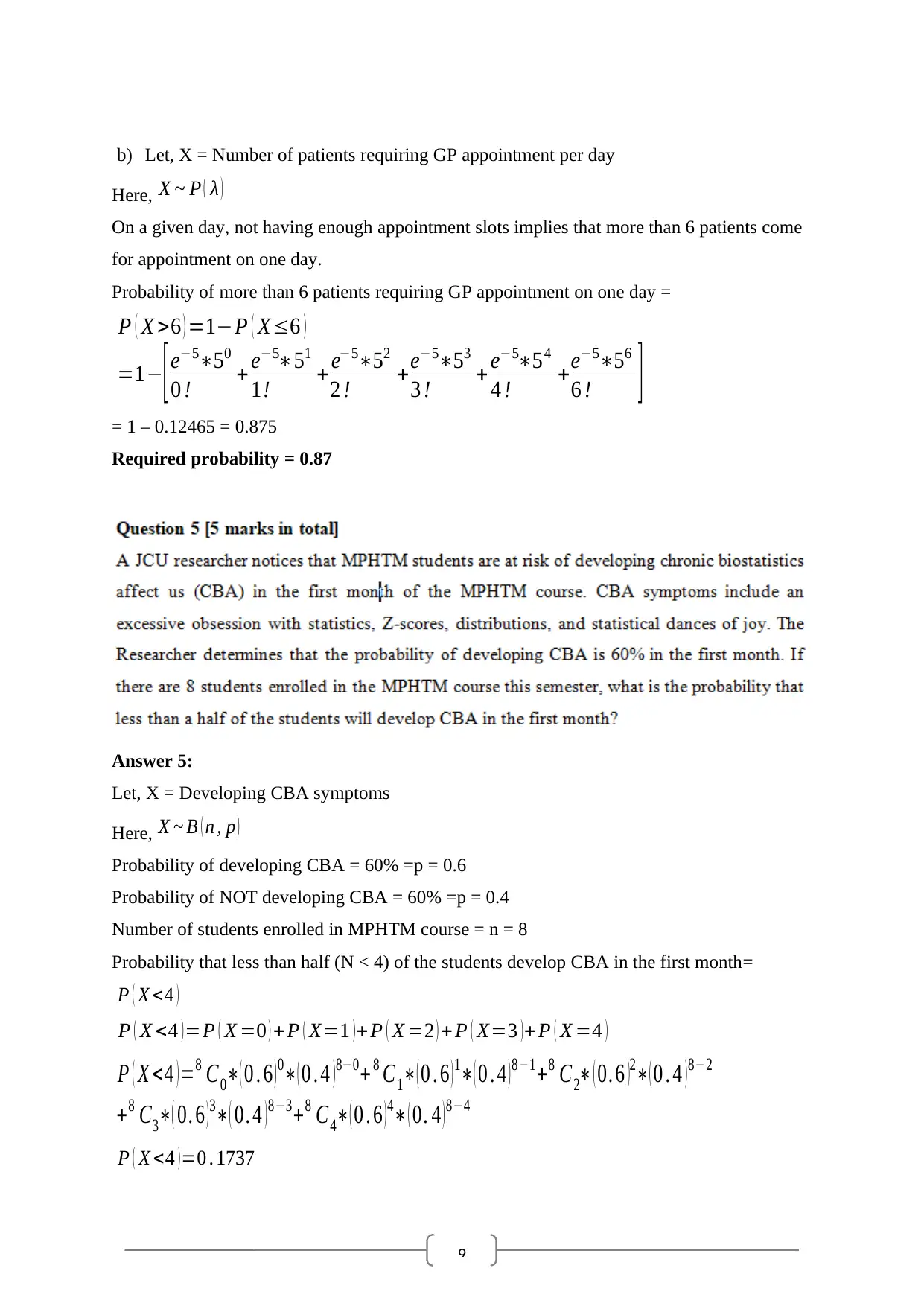
9
b) Let, X = Number of patients requiring GP appointment per day
Here, X ~ P ( λ )
On a given day, not having enough appointment slots implies that more than 6 patients come
for appointment on one day.
Probability of more than 6 patients requiring GP appointment on one day =
P ( X >6 ) =1−P ( X≤6 )
=1−[ e−5∗50
0 ! + e−5∗51
1! + e−5∗52
2 ! +e−5∗53
3 ! + e−5∗54
4 ! +e−5∗56
6 ! ]
= 1 – 0.12465 = 0.875
Required probability = 0.87
Answer 5:
Let, X = Developing CBA symptoms
Here, X ~ B ( n , p )
Probability of developing CBA = 60% =p = 0.6
Probability of NOT developing CBA = 60% =p = 0.4
Number of students enrolled in MPHTM course = n = 8
Probability that less than half (N < 4) of the students develop CBA in the first month=
P ( X <4 )
P ( X <4 ) =P ( X =0 ) + P ( X=1 ) + P ( X =2 ) + P ( X=3 ) + P ( X =4 )
P ( X <4 ) =8 C0∗( 0 . 6 ) 0∗( 0 . 4 ) 8−0+ 8 C1∗( 0 . 6 ) 1∗( 0 . 4 ) 8−1+8 C2∗ ( 0. 6 )2∗( 0 . 4 ) 8−2
+8 C3∗( 0. 6 ) 3∗( 0. 4 ) 8−3+8 C4∗( 0 . 6 ) 4∗ ( 0. 4 ) 8−4
P ( X <4 ) =0 . 1737
b) Let, X = Number of patients requiring GP appointment per day
Here, X ~ P ( λ )
On a given day, not having enough appointment slots implies that more than 6 patients come
for appointment on one day.
Probability of more than 6 patients requiring GP appointment on one day =
P ( X >6 ) =1−P ( X≤6 )
=1−[ e−5∗50
0 ! + e−5∗51
1! + e−5∗52
2 ! +e−5∗53
3 ! + e−5∗54
4 ! +e−5∗56
6 ! ]
= 1 – 0.12465 = 0.875
Required probability = 0.87
Answer 5:
Let, X = Developing CBA symptoms
Here, X ~ B ( n , p )
Probability of developing CBA = 60% =p = 0.6
Probability of NOT developing CBA = 60% =p = 0.4
Number of students enrolled in MPHTM course = n = 8
Probability that less than half (N < 4) of the students develop CBA in the first month=
P ( X <4 )
P ( X <4 ) =P ( X =0 ) + P ( X=1 ) + P ( X =2 ) + P ( X=3 ) + P ( X =4 )
P ( X <4 ) =8 C0∗( 0 . 6 ) 0∗( 0 . 4 ) 8−0+ 8 C1∗( 0 . 6 ) 1∗( 0 . 4 ) 8−1+8 C2∗ ( 0. 6 )2∗( 0 . 4 ) 8−2
+8 C3∗( 0. 6 ) 3∗( 0. 4 ) 8−3+8 C4∗( 0 . 6 ) 4∗ ( 0. 4 ) 8−4
P ( X <4 ) =0 . 1737
⊘ This is a preview!⊘
Do you want full access?
Subscribe today to unlock all pages.

Trusted by 1+ million students worldwide
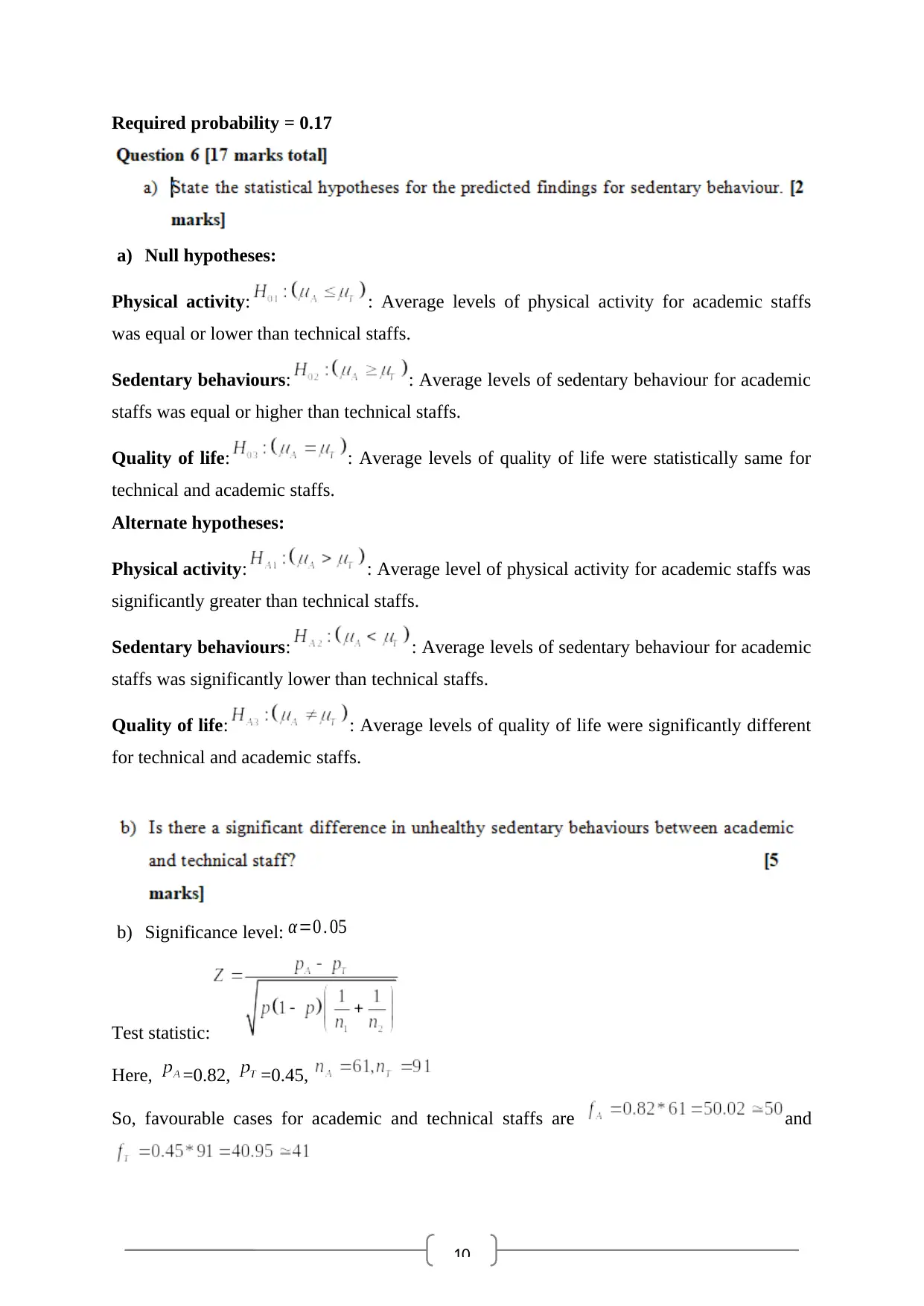
10
Required probability = 0.17
a) Null hypotheses:
Physical activity: : Average levels of physical activity for academic staffs
was equal or lower than technical staffs.
Sedentary behaviours: : Average levels of sedentary behaviour for academic
staffs was equal or higher than technical staffs.
Quality of life: : Average levels of quality of life were statistically same for
technical and academic staffs.
Alternate hypotheses:
Physical activity: : Average level of physical activity for academic staffs was
significantly greater than technical staffs.
Sedentary behaviours: : Average levels of sedentary behaviour for academic
staffs was significantly lower than technical staffs.
Quality of life: : Average levels of quality of life were significantly different
for technical and academic staffs.
b) Significance level: α=0 . 05
Test statistic:
Here, =0.82, =0.45,
So, favourable cases for academic and technical staffs are and
Required probability = 0.17
a) Null hypotheses:
Physical activity: : Average levels of physical activity for academic staffs
was equal or lower than technical staffs.
Sedentary behaviours: : Average levels of sedentary behaviour for academic
staffs was equal or higher than technical staffs.
Quality of life: : Average levels of quality of life were statistically same for
technical and academic staffs.
Alternate hypotheses:
Physical activity: : Average level of physical activity for academic staffs was
significantly greater than technical staffs.
Sedentary behaviours: : Average levels of sedentary behaviour for academic
staffs was significantly lower than technical staffs.
Quality of life: : Average levels of quality of life were significantly different
for technical and academic staffs.
b) Significance level: α=0 . 05
Test statistic:
Here, =0.82, =0.45,
So, favourable cases for academic and technical staffs are and
Paraphrase This Document
Need a fresh take? Get an instant paraphrase of this document with our AI Paraphraser
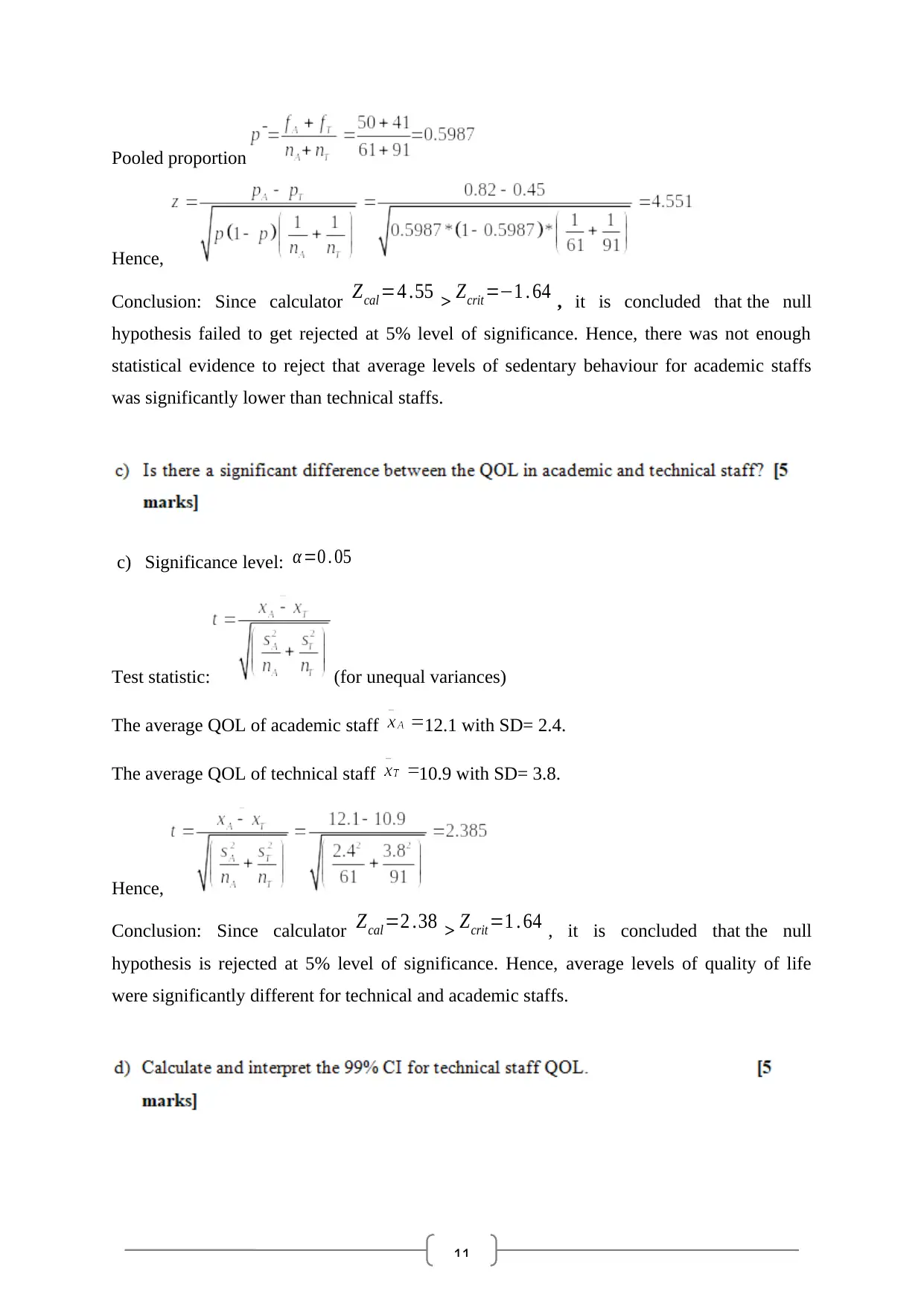
11
Pooled proportion
Hence,
Conclusion: Since calculator Zcal =4 .55 > Zcrit =−1 . 64 , it is concluded that the null
hypothesis failed to get rejected at 5% level of significance. Hence, there was not enough
statistical evidence to reject that average levels of sedentary behaviour for academic staffs
was significantly lower than technical staffs.
c) Significance level: α =0 . 05
Test statistic: (for unequal variances)
The average QOL of academic staff 12.1 with SD= 2.4.
The average QOL of technical staff 10.9 with SD= 3.8.
Hence,
Conclusion: Since calculator Zcal =2 .38 > Zcrit =1 . 64 , it is concluded that the null
hypothesis is rejected at 5% level of significance. Hence, average levels of quality of life
were significantly different for technical and academic staffs.
Pooled proportion
Hence,
Conclusion: Since calculator Zcal =4 .55 > Zcrit =−1 . 64 , it is concluded that the null
hypothesis failed to get rejected at 5% level of significance. Hence, there was not enough
statistical evidence to reject that average levels of sedentary behaviour for academic staffs
was significantly lower than technical staffs.
c) Significance level: α =0 . 05
Test statistic: (for unequal variances)
The average QOL of academic staff 12.1 with SD= 2.4.
The average QOL of technical staff 10.9 with SD= 3.8.
Hence,
Conclusion: Since calculator Zcal =2 .38 > Zcrit =1 . 64 , it is concluded that the null
hypothesis is rejected at 5% level of significance. Hence, average levels of quality of life
were significantly different for technical and academic staffs.
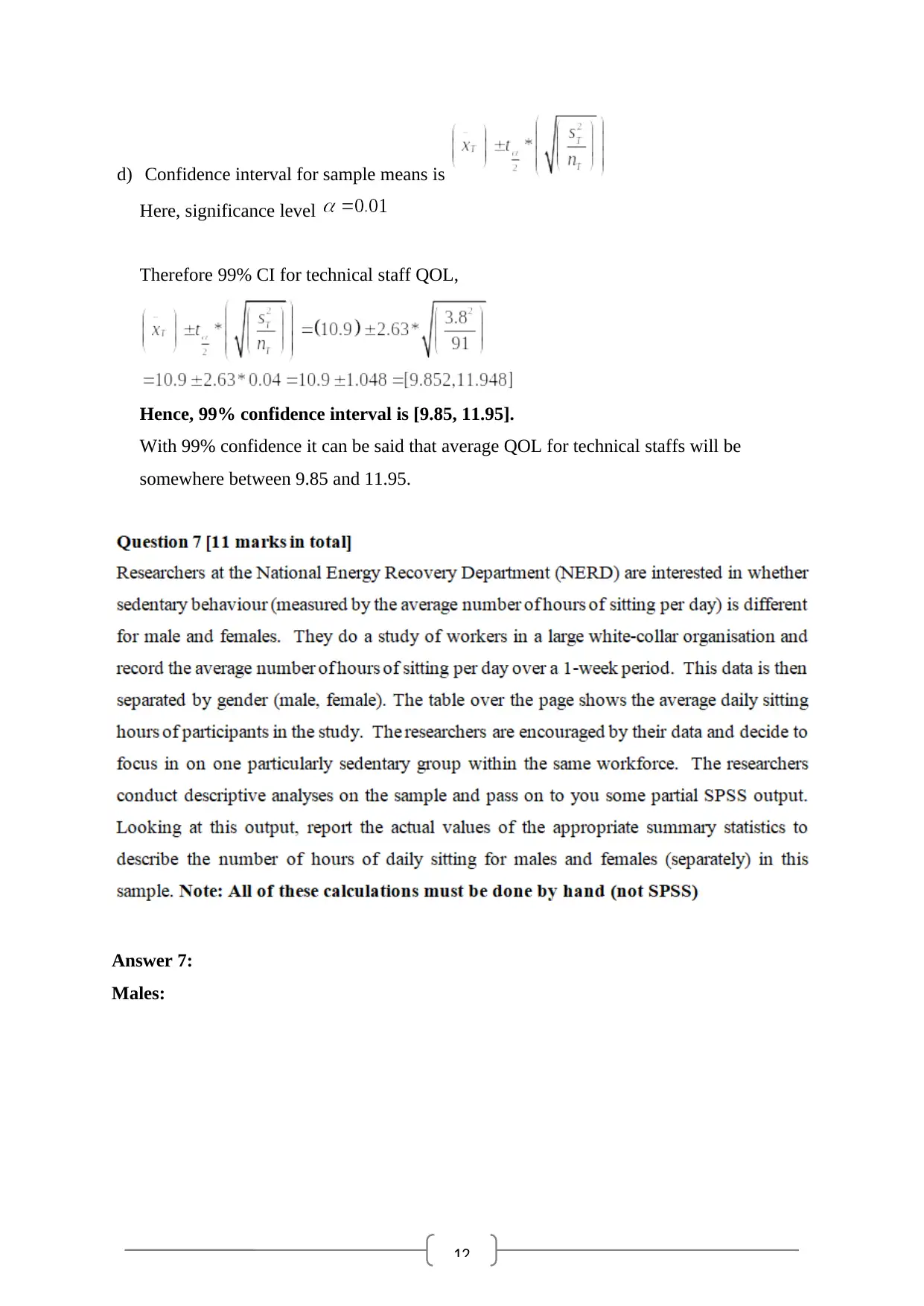
12
d) Confidence interval for sample means is
Here, significance level
Therefore 99% CI for technical staff QOL,
Hence, 99% confidence interval is [9.85, 11.95].
With 99% confidence it can be said that average QOL for technical staffs will be
somewhere between 9.85 and 11.95.
Answer 7:
Males:
d) Confidence interval for sample means is
Here, significance level
Therefore 99% CI for technical staff QOL,
Hence, 99% confidence interval is [9.85, 11.95].
With 99% confidence it can be said that average QOL for technical staffs will be
somewhere between 9.85 and 11.95.
Answer 7:
Males:
⊘ This is a preview!⊘
Do you want full access?
Subscribe today to unlock all pages.

Trusted by 1+ million students worldwide
1 out of 17
Your All-in-One AI-Powered Toolkit for Academic Success.
+13062052269
info@desklib.com
Available 24*7 on WhatsApp / Email
![[object Object]](/_next/static/media/star-bottom.7253800d.svg)
Unlock your academic potential
Copyright © 2020–2025 A2Z Services. All Rights Reserved. Developed and managed by ZUCOL.